Secret Gardens: Exploring Shaftesbury Capital's Wild Rooftop in Carnaby Street
Posted by SECRET GARDENER

Shaftesbury Capital is a founding member of Wild West End, and the leading central London mixed-use REIT (real estate investment trust).
Working with Central London’s largest property owners, Wild West End aims to encourage wildlife back into the heart of London, and create spaces for residents, visitors, and workers to enjoy a connection to nature.
We toured the beautiful rooftop garden at the top of Shaftesbury Capital’s head office in Soho, with Fiona Daly, ahead of London Open Gardens Weekend where other nearby buildings including the Ham Yard Hotel will open their green spaces to the public (10–11 June 2023).
***
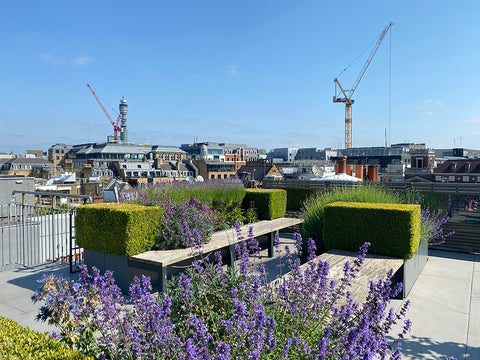 Above: The garden has plenty of seating areas overlooking panoramic views
Above: The garden has plenty of seating areas overlooking panoramic views
Where is your garden located?
Shaftesbury Capital office rooftop at 22 Ganton Street, Soho
How long has the garden been here?
FD: The garden has been in its current state for about six years. When we moved here in 2014, the existing roof space wasn’t practical for our needs – it’s since been completely redesigned and a wonderful company (Greenmantle Landscapes) keep it looking good!
What was the purpose of the garden?
FD: Green space is important for staff well-being and get togethers, and it’s great for everyone to have access to a space like this where they can enjoy an outdoor lunch and be close to nature.
As we’re part of Wild West End, the planting scheme is focussed on bringing together native and flowering plants to provide food for pollinators – like the bees we keep on the opposite roof. The garden is not open to the public but a few years ago we opened it up for the weekend and had about 400 visitors!
(This was for the National Park City Festival in 2019 hosted London National Park City and the Mayor of London, to celebrate London becoming a National Park City.)
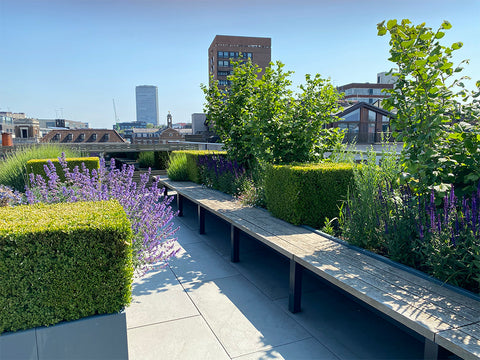 Above: Salvia and Erigeron amongst the Buxus in the garden.
Above: Salvia and Erigeron amongst the Buxus in the garden.
It’s amazing how many gardens like this must exist, but when you’re on the ground you just have no idea what’s above you.
FD: Yes, and people understandably really want access to outside space! Where possible, we're providing as much outside space as we can. For example, over at 72 Broadwick Street (which we can see from the rooftop), that has been a green space for a while, but we’ve now changed it to have a function so people can sit out on it, and there is a green wall and nice terraces.
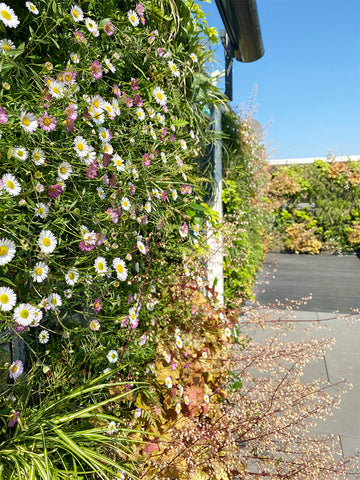 Above: Erigeron and Heuchera growing on a green wall in the garden
Above: Erigeron and Heuchera growing on a green wall in the garden
Plants in the garden: pollinator-friendly flowers, shrubs, and trees
In the garden, most of the summer flowers are in shades of purple and blue. Carefully chosen plants like Salvia, Lavender, Thistles, and Alliums, nestled amongst the pretty daisy-like Erigeron (fleabane) and Buxus hedging have been selected for their vibrant colours. These are the shades that bees see best as their eyes are the most sensitive to purple and blue.
Flowering plants are an important source of nectar during the spring and summer months for pollinators like bees and butterflies – and the garden is teeming with bees!
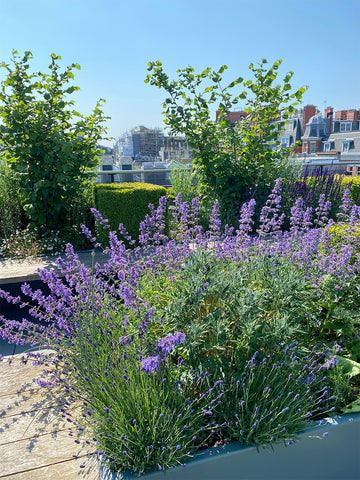 Above: Salvia and blue thistle growing in the garden
Above: Salvia and blue thistle growing in the garden
FD: What the garden maintenance team have discovered with our green walls is that while they’re great at providing homes for bugs and insects, they function even better with planting, like Buxus hedging, beneath them. The biodiversity of the garden is improved, and the bugs especially love it as they have more hidden spaces to crawl into and out of.
So, is that the focus of the garden, to encourage wildlife?
FD: Yes, and birds as well. We don’t get many birds other than pigeons, magpies and gulls! We have the odd bird now and again (we were lucky enough to see some House Sparrows during our visit).

Above: one of the green walls in the garden with an insect hotel, which has underplanting to encourage wildlife to flourish. Plants include Heuchera, with Buxus and Alliums underneath.
FD: The theme of the garden is to encourage biodiversity, which is a key aim from the Wild West End project. We’re trying to create a green corridor through a city where outside space is very limited.
Where did the bees come from?
FD: The previous owners of 72 Broadwick Street had a small garden terrace with beehives and a bee club for the staff. The new offices they were moving to unfortunately couldn't take the bees. So, we adopted their bees and that’s how our story began.
Beekeeper Luke Dixon (co-founder of the Bee Friendly Trust and Soho resident) looked after our bees until he retired, and now Montserrat, a local beekeeper, looks after them. The bees produce honey, some of which is left in the hive to keep the colony going over the winter months, and Montserrat bottles up the surplus for us which staff enjoy.
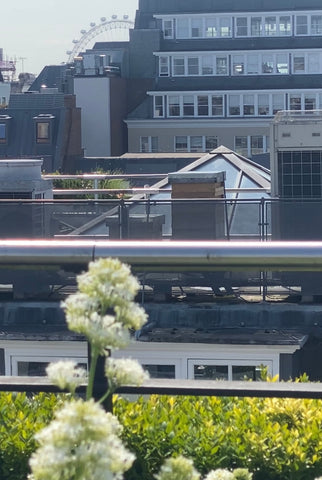 Above: a beehive on the rooftop opposite the garden
Above: a beehive on the rooftop opposite the garden
The Carnaby Street bee swarm
FD: Over the years we have had a couple of bee swarms, which has been challenging. Once the hive becomes too big then the colony will split, and they have to find a location to start a new colony. But once a hive swarms the public can become frightened, as you see the bees in a large cloud which can be alarming.
The last time a swarm happened the bees had gathered around a light on the side of one of the pubs on Carnaby Street. Luke sprayed them with water and put a box beneath them, and they all fell into the box - including the queen. It was lucky he caught the queen as the rest of the swarm followed her into the box. He then transferred them into one of our spare hives.
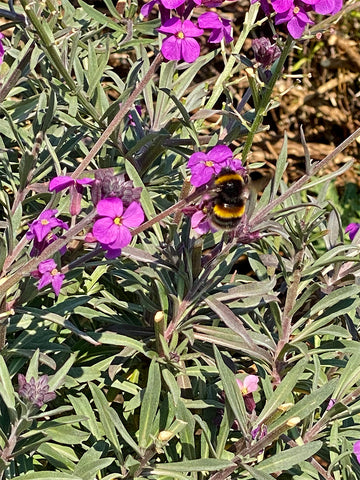 Above: a honeybee enjoys the Erisymum flowers in the garden
Above: a honeybee enjoys the Erisymum flowers in the garden
Why do bees swarm?
When an established colony of honeybees gets larger, they need more space for the population. Swarming is a natural process where a group of bees will leave the established colony to look for somewhere else to create a new colony. Once they leave the hive they will find somewhere to ‘cluster’ while scout bees look for a new home. In this case, the cluster happened in Carnaby Street!
***
Next time you're in Soho, look up!

Above: the edges of the Buxus planting in the rooftop garden as seen from Ganton Street
Explore secret rooftop gardens like Shaftesbury Capital's garden and London's lesser-known green spaces this weekend during London Open Gardens weekend (10 – 11 June 2023) where offices, hotels, private squares and more will give the public the opportunity to tour their gardens.

With thanks for Fiona Daly for showing us around Shaftesbury Capital's garden.
The garden is maintained by Greenmantle Landscapes
If you would like to tell your gardening story, we would love to hear from you. Get in touch at florist@stormflowerslondon.com

